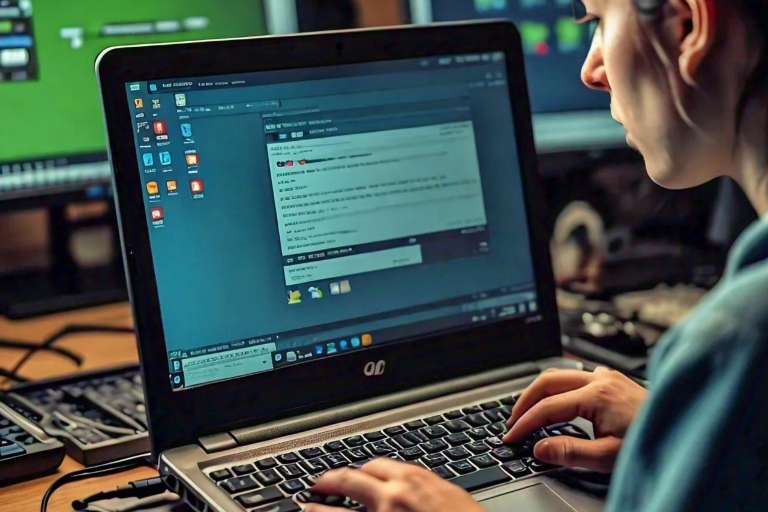The Intersection of Artificial Intelligence, Laptops, Machine Learning, and Computing

In the rapidly evolving landscape of technology, the convergence of artificial intelligence (AI), laptops, machine learning (ML), and computing has become a pivotal point for innovation and progress. This article delves into how these four elements are intertwined, highlighting their significance in shaping the future of computing and beyond.
Artificial Intelligence: The Backbone of Modern Computing
Artificial Intelligence, often abbreviated as AI, refers to the simulation of human intelligence processes by machines, especially computer systems. These processes include learning (the acquisition of information and rules for using the information), reasoning (using the rules to reach approximate or definite conclusions), and self-correction. AI has been instrumental in revolutionizing various sectors, including healthcare, finance, transportation, and entertainment, by automating complex tasks and making predictions based on data analysis.
Machine Learning: The Engine of AI
Machine Learning (ML) is a subset of AI that focuses on the development of algorithms and statistical models that enable computers to perform tasks without explicit instructions, relying instead on patterns and inference. ML algorithms learn from and make decisions or predictions based on data. It’s the engine that powers many AI applications, enabling them to adapt and improve over time.

How to create and train machine learning models on laptops.
1. Data Collection and Preprocessing:
- Gather relevant data for your machine learning task. This could involve collecting data from various sources, such as databases, APIs, or web scraping.
- Preprocess the data by cleaning it, handling missing values, and formatting it for use in machine learning algorithms.
- Split the data into training and testing sets.
2. Choose a Machine Learning Algorithm:
- Select an appropriate machine learning algorithm based on your problem type (e.g., classification, regression, clustering) and the characteristics of your data.
- Popular algorithms for laptops include linear regression, logistic regression, decision trees, random forests, support vector machines (SVMs), and neural networks.
3. Set up the Development Environment:
- Install the necessary machine learning libraries and frameworks on your laptop, such as scikit-learn, TensorFlow, or PyTorch.
- Configure an integrated development environment (IDE) or code editor for writing and running your machine learning code.
4. Feature Engineering:
- Identify and extract relevant features from your data that will be used as input to the machine learning model.
- This may involve techniques like one-hot encoding, feature scaling, and dimensionality reduction.
5. Model Training:
- Split your preprocessed data into training and validation sets.
- Define the model architecture or algorithm parameters.
- Train the model using the training data.
- Monitor the training process and adjust hyperparameters if necessary.
6. Model Evaluation:
- Evaluate the trained model’s performance on the validation set using appropriate metrics (e.g., accuracy, precision, recall, F1-score, mean squared error).
- Techniques like cross-validation can be used to assess the model’s generalization performance.
7. Model Tuning:
- If the model’s performance is not satisfactory, explore techniques like hyperparameter tuning, feature selection, or trying different algorithms.
- Iterate through steps 5-7 until you achieve desired performance.
8. Model Deployment:
- Once you have a well-performing model, you can deploy it on your laptop for making predictions on new data.
- This may involve integrating the model into an application or creating a web service or API.
The intersection of artificial intelligence (AI), laptops, machine learning, and computing has far-reaching implications across various domainsw
The integration of AI and machine learning algorithms with powerful laptop hardware and computing resources has significantly increased the computational capabilities available to individuals and organizations. This has enabled more complex data processing, analysis, and decision-making processes to be performed on portable devices.
AI and machine learning techniques are being employed in laptop operating systems, applications, and user interfaces to provide more intuitive and personalized experiences. Features like voice assistants, predictive text, and context-aware recommendations are becoming increasingly common, enhancing productivity and convenience.
The convergence of these technologies has facilitated the development of innovative solutions across industries. For example, in healthcare, AI-powered laptops can assist in medical image analysis, drug discovery, and personalized treatment planning. In finance, machine learning algorithms can analyze vast amounts of data to identify patterns, make predictions, and optimize investment strategies.
The accessibility of AI and machine learning on laptops has democratized these technologies, making them available to a broader range of users, including students, researchers, and small businesses. This has fostered innovation and enabled individuals and organizations with limited resources to leverage the power of AI.
As AI and machine learning become more prevalent, concerns related to privacy, security, bias, and transparency have emerged. The integration of these technologies into laptops and computing devices raises questions about data privacy, algorithmic fairness, and the responsible development and deployment of AI systems.
The Convergence of AI, Laptops, and Computing: Navigating the Opportunities and Challenges
In today’s rapidly evolving digital landscape, the intersection of artificial intelligence (AI), laptops, machine learning, and computing has emerged as a powerful force, reshaping the way we live, work, and interact with technology. While this convergence holds immense potential, it also raises important questions and challenges that demand our attention.
The Promise of Enhanced Capabilities
Imagine a world where your laptop becomes an intelligent companion, seamlessly adapting to your preferences and needs. AI and machine learning algorithms integrated into our personal devices can revolutionize the user experience, offering intuitive voice assistants, predictive text, and context-aware recommendations. This not only enhances productivity but also fosters a more personalized and convenient computing experience.
Moreover, the computational prowess unleashed by the fusion of AI, laptops, and computing has opened up new frontiers of innovation across various domains. From healthcare to finance, these technologies are enabling groundbreaking solutions, such as medical image analysis, drug discovery, and sophisticated financial modeling. The possibilities seem limitless, as we harness the power of data analysis and decision-making on portable devices.
Navigating the Challenges
However, as with any transformative technology, this convergence also presents a set of challenges that we must address proactively.
Privacy and Security Concerns: The collection and processing of vast amounts of user data by AI systems raise legitimate concerns about privacy and data security. As these technologies become more integrated into our personal devices, we must ensure robust safeguards and transparent policies to protect our digital identities and prevent unauthorized access or misuse of sensitive information.
Algorithmic Bias and Discrimination: Machine learning algorithms can inadvertently perpetuate or amplify existing biases present in the training data or models. This can lead to discriminatory outcomes, particularly in sensitive areas like hiring, lending, or criminal justice. Ensuring algorithmic fairness and mitigating bias is a crucial challenge that demands collaborative efforts from researchers, developers, and policymakers.
Environmental Impact: The computational demands of AI and machine learning algorithms can contribute to increased energy consumption and a larger carbon footprint, especially when running on resource-constrained laptops. As stewards of our planet, we must explore innovative solutions to reduce the environmental impact of these technologies and promote sustainability.
Workforce Disruption and Job Displacement: The automation capabilities of AI and machine learning systems may lead to job displacement in certain industries and occupations. While new job opportunities may emerge, we must proactively address the risk of skills mismatch and provide adequate support for workers whose tasks can be automated.
Digital Divide and Accessibility: The adoption of AI-powered laptops and computing devices may exacerbate the digital divide, as access to these technologies and the skills required to utilize them effectively may be limited for certain populations. Addressing this issue is crucial to ensure that the benefits of these technologies are accessible to all, regardless of socioeconomic status or geographic location.
Ethical and Legal Challenges: The use of AI and machine learning on personal devices raises ethical and legal questions related to accountability, transparency, and the responsible development and deployment of these systems. Determining liability in case of errors or undesirable outcomes can be challenging, and regulatory frameworks must evolve to keep pace with rapid technological advancements.
A Balanced Approach
As we navigate this exciting yet complex landscape, it is essential to strike a balance between embracing the transformative potential of AI, laptops, and computing while proactively addressing the associated challenges. Collaboration among researchers, developers, policymakers, and the broader society is paramount to ensure the responsible and ethical development and deployment of these technologies.
We must foster open dialogue, prioritize transparency, and continuously assess the societal implications of our technological pursuits. By doing so, we can harness the power of AI, laptops, and computing to create a future that is not only technologically advanced but also equitable, sustainable, and respectful of fundamental human rights and values.



